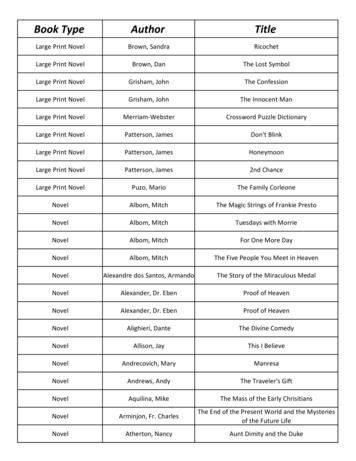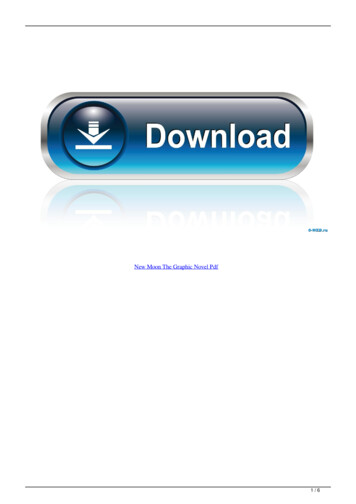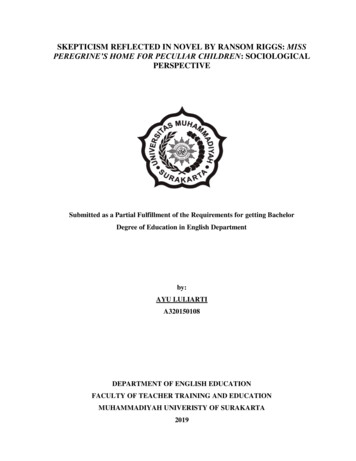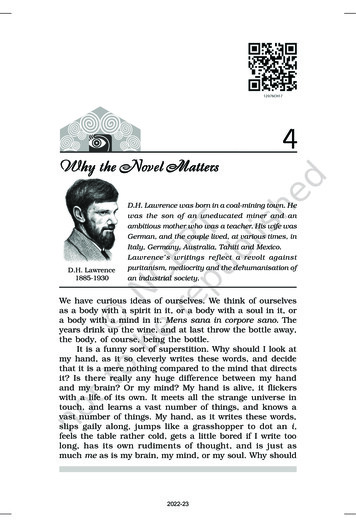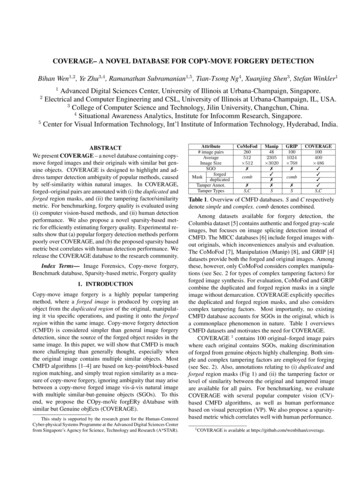
Transcription
COVERAGE– A NOVEL DATABASE FOR COPY-MOVE FORGERY DETECTIONBihan Wen1,2 , Ye Zhu3,4 , Ramanathan Subramanian1,5 , Tian-Tsong Ng4 , Xuanjing Shen3 , Stefan Winkler11Advanced Digital Sciences Center, University of Illinois at Urbana-Champaign, Singapore.Electrical and Computer Engineering and CSL, University of Illinois at Urbana-Champaign, IL, USA.3College of Computer Science and Technology, Jilin University, Changchun, China.4Situational Awareness Analytics, Institute for Infocomm Research, Singapore.5Center for Visual Information Technology, Int’l Institute of Information Technology, Hyderabad, India.2ABSTRACTWe present COVERAGE – a novel database containing copymove forged images and their originals with similar but genuine objects. COVERAGE is designed to highlight and address tamper detection ambiguity of popular methods, causedby self-similarity within natural images. In COVERAGE,forged–original pairs are annotated with (i) the duplicated andforged region masks, and (ii) the tampering factor/similaritymetric. For benchmarking, forgery quality is evaluated using(i) computer vision-based methods, and (ii) human detectionperformance. We also propose a novel sparsity-based metric for efficiently estimating forgery quality. Experimental results show that (a) popular forgery detection methods performpoorly over COVERAGE, and (b) the proposed sparsity basedmetric best correlates with human detection performance. Werelease the COVERAGE database to the research community.Index Terms— Image Forensics, Copy-move forgery,Benchmark database, Sparsity-based metric, Forgery quality1. INTRODUCTIONCopy-move image forgery is a highly popular tamperingmethod, where a forged image is produced by copying anobject from the duplicated region of the original, manipulating it via specific operations, and pasting it onto the forgedregion within the same image. Copy-move forgery detection(CMFD) is considered simpler than general image forgerydetection, since the source of the forged object resides in thesame image. In this paper, we will show that CMFD is muchmore challenging than generally thought, especially whenthe original image contains multiple similar objects. MostCMFD algorithms [1–4] are based on key-point/block-basedregion matching, and simply treat region similarity as a measure of copy-move forgery, ignoring ambiguity that may arisebetween a copy-move forged image vis-á-vis natural imagewith multiple similar-but-genuine objects (SGOs). To thisend, we propose the COpy-moVe forgERy dAtabase withsimilar but Genuine objEcts (COVERAGE).This study is supported by the research grant for the Human-CenteredCyber-physical Systems Programme at the Advanced Digital Sciences Centerfrom Singapore’s Agency for Science, Technology and Research (A*STAR).Attribute# image pairsAverageImage SizeSGOforgedMaskduplicatedTamper Annot.Tamper TypesCoMoFod260512 5127comb7S,CManip482305 30207377SGRIP1001024 7687comb7SCOVERAGE100400 4863333S,CTable 1. Overview of CMFD databases. S and C respectivelydenote simple and complex. comb denotes combined.Among datasets available for forgery detection, theColumbia dataset [5] contains authentic and forged gray-scaleimages, but focuses on image splicing detection instead ofCMFD. The MICC databases [6] include forged images without originals, which inconveniences analysis and evaluation.The CoMoFod [7], Manipulation (Manip) [8], and GRIP [4]datasets provide both the forged and original images. Amongthese, however, only CoMoFod considers complex manipulations (see Sec. 2 for types of complex tampering factors) forforged image synthesis. For evaluation, CoMoFod and GRIPcombine the duplicated and forged region masks in a singleimage without demarcation. COVERAGE explicitly specifiesthe duplicated and forged region masks, and also considerscomplex tampering factors. Most importantly, no existingCMFD database accounts for SGOs in the original, which isa commonplace phenomenon in nature. Table 1 overviewsCMFD datasets and motivates the need for COVERAGE.COVERAGE 1 contains 100 original–forged image pairswhere each original contains SGOs, making discriminationof forged from genuine objects highly challenging. Both simple and complex tampering factors are employed for forging(see Sec. 2). Also, annotations relating to (i) duplicated andforged region masks (Fig 1) and (ii) the tampering factor orlevel of similarity between the original and tampered imageare available for all pairs. For benchmarking, we evaluateCOVERAGE with several popular computer vision (CV)based CMFD algorithms, as well as human performancebased on visual perception (VP). We also propose a sparsitybased metric which correlates well with human performance.1 COVERAGEis available at https://github.com/wenbihan/coverage.
(a) Scaling to ϕ 0.8(b) Rotation by θ 10 (c) Illumination changeFig. 1. Exemplar original–forged image pairs with tampering factor specified for simple transformations (a) and (b). Theduplicated and forged regions are respectively highlighted in green and red.2. DATABASE GENERATIONOriginal images in COVERAGE were acquired using anIphone 6 front camera. We captured both indoor and outdoor scenes for the purpose of this study. These scenes arehighly diverse, including stores, offices, public spaces, placesof leisure, etc, which are highly representative of everydayscenes [9]. A region of interest containing at least two SGOswas cropped from each image, and stored in lossless TIFFformat as the original image corresponding to each pair. Aforged image was synthesized via graphical manipulation ofthe original using Photoshop CS4 and also stored as losslessTIFF: One of the original SGOs served as the duplicatedregion, and was transformed via one of the simple or complextamperings specified below to replace another similar object,and synthesize the forged image.Masks corresponding to the duplicated and forged regionsare annotated for all image pairs as in Fig. 1. Six types oftampering were employed for forged image generation:i. Translation– the duplicated object (DO) is directlytranslated and pasted onto the forged region withoutany manipulation.ii. Scaling– DO is scaled by a factor of ϕ followed bytranslation (FBT).iii. Rotation– DO is rotated clockwise by θ FBT.iv. Free-form– DO is distorted via a free transform FBT.v. Illumination– DO is modified via lighting effects FBT.vi. Combination– DO is manipulated via more than oneof the above factors FBT.Factors (i) to (iii) denote Simple tampering, since theyare easily reproducible with a given parameter. Factors (iv) to(vi) denote Complex tampering, and normally contain multiple transformations. For simple tampering, we annotate theoriginal–forged image pair with the tampering level specifiedby a single parameter. For complex tampering, we employsimilarity metrics to discriminate forged regions from originals as discussed in Section 3.3. FORGERY QUALITY ESTIMATION METRICSFor the purpose of (a) describing complex transformations,(b) benchmarking CMFD performance on COVERAGE, and(c) demonstrating the challenge posed by SGOs, we attemptto estimate forgery quality in this section. As forgery qualityestimation is an open question [10, 11], we explore variousmetrics to this end. These metrics are intended to serve as aguide for tamper detection difficulty, and not for CMFD performance evaluation per se.3.1. CMFD BenchmarkTo benchmark the forgery quality, we used both CV andVP-based detection performance. Popular CV-based CMFDmethods include SIFT [1] and SURF [3] based on key-pointfeatures, and the recent dense-field method [4] which employsfeatures of densely overlapping blocks. All three methods arecapable of matching copy-move key point/block pairs automatically. We follow the original/forged image identificationmethodology in [1] to compute detection accuracy.Though CV methods provide for fast evaluation, the copymove image forgery is essentially aimed to cheat the humaneye. In order to study VP-based tamper detection performance, we designed a user study where 30 viewers were required to determine the forged image from each pair uponvisual inspection. Mean human detection accuracy in alsospecified for each COVERAGE pair.3.2. Spatial Similarity MetricsTampering methods are designed to enhance the spatial similarity between the forged and original images, especially forthose with SGOs. A poorly forged image usually deviatesconsiderably from its original version, and can thus be easilydetected. Amongst existing metrics, we consider Peak Signalto-Noise Ratio (PSNR) [12] (in decibels) and structural similarity (SSIM) [13] computed on 3 3 overlapping windowsof the forged and original images, as global similarity metrics.PSNR and SSIM are commonly used for measuring image reconstruction quality.Since the PSNR and SSIM measures capture global imagesimilarity, they tend to decrease when the image and forgedregion differs in size. A better similarity metric in such casesis the forged region PNSR (fPSNR), which focuses solely onthe tampered region. Denoting the forged and original imagesas X, Y RP K , where P is the number of image pixels andK is the number of color channels (K 1 for grayscale and3 for RGB), fPSNR is defined as(fPSNR 20 log10255 K k 1 K Cf i Cfi Y i )2(Xkk)(1)
patches with sparsity level smaller than s, while (.)H denotesthe Hermitian operator. The solutions Ŵf and Ŵo are both restricted to be unitary. Problem (P1) can be solved by alternating between sparse coding and transform update steps, bothof which have{closed-form} solutions [19]. Denote the learnedUOT as U Ŵf , Ŵo . We evaluate the normalized UOTmodeling error for the forged image, denoted as Ef , using thepatches centered at the boundary B. Each patch selects eitherŴf or Ŵo to ensure smaller modeling error. The normalizedforged image UOT modeling error Ef is calculated as Ef Fig. 2. Original (top) and forged images (bottom), with theforged region boundary in red (left), and a zoom-in of thepatches centered at the boundary (right).where Cf denotes the set of pixels corresponding to theforged region. {Xki , Yki }, i Cf denotes the ith pixel pairin Cf derived from the k th channel of X and Y. Differentfrom PSNR and SSIM, fPSNR is a tamper quality estimationmetric invariant to forged region size.3.3. Forgery Edge Abnormality Using Adaptive SparsityHuman forgery detection typically employs the forged edgeabnormality (FEA) as an important clue [14, 15]. To circumvent the need for involving users but emulate human detectionperformance, we propose a sparsity-based metric measuringFEA. Figure 2 visualizes FEA for the original and forged images. Natural images are usually sparsifiable [16, 17], whilethe imperfect object embedding in image tampering producesunnatural local artifacts at the boundary [18] as highlightedin Fig. 2. CMFD algorithms are normally insensitive to suchartifacts, which can be easily captured by the human eye andfacilitate VP-based forgery detection. Inspired by the unionof-transforms (UOT) model [19], we compute the FEA metricvia adaptive UOT-domain sparsity.To this end, we first calculate the adaptive sparse modeling error for forged images. Define Y and X to be the originaland forged images, and B to be the set of pixels at the boundary of the forged region Cf and the background Cf . Weextract overlapping patches that are centered at the interior ofCf , denoted as {Rj Y}j Cf , j̸ B , where Rj extracts the j thpatch within the set of pixels. The sparsifying transforms Wfand Wo model Cf and Cf respectively. The optimal Ŵfand Ŵo are obtained by solving (P1), 2(P1) Ŵf argmin Wf Rj X αj 2Wf ,{αj } j C , j̸ BfŴo argmin Wo ,{βi } i C , i̸ Bf2 Wo Ri X βi 2s.t. αj 0 , βi 0 s, i, j, WfH Wf I, WoH Wo I.Here {αj } and {βi } are the sparse codes of the extractedj BminW U W Rj X Proj0,s (W Rj X) 2j B Rj X 222(2)where Proj0,s (·) denotes l0 ball projection [19] with maximum sparsity level s.To calculate the normalized UOT modeling error for original images, we follow the same algorithm but using boundary patches extracted from Y to obtain Eo in a similar way.The proposed FEA metric is defined as the difference of thenormalized UOT modeling errors,FEA Ef Eo(3)Forged images with boundary patches satisfying the adaptiveUOT model usually correspond to a small FEA value, andare thus considered well tampered (i.e., contain less unnaturalartifacts). A well-forged image is also less likely to be detected by a human, and therefore corresponds to a lower VPbased detection accuracy. We observe this linear correlationbetween FEA and human performance in Section 4.4. EXPERIMENTAL RESULTS AND ANALYSISTamp. factor(#images)Trans. (16)SScal. (16)Rot. (16)Free. (16)CIllum. (16)Comb. (20)Overall (100)Spatial SimilaritySSIMPSNR .569.9CV(%)72.962.562.259.456.353.360.3Table 2. Mean spatial similarity scores, FEA metric, VP andCV-based detection accuracy for simple (S) and complex (C)tampering factors in COVERAGE.We firstly evaluate forgery quality in COVERAGE usingthe metrics proposed in Section 3. All image pairs in COVERAGE are annotated and categorized based on their tampering factors. Table 2 lists the mean spatial similarity scores,sparsity-based FEA values, VP, and CV detection accuraciesfor each category, as well as for the whole database. TheCV-based CMFD accuracy is obtained by averaging the results from the SIFT [1], SURF [3] and dense-field [4] CMFDmethods. Given that the aim of tampering is to escape human detection, the forgeries that are more difficult to detect
(a) Original, CoMoFod(b) Forged, CoMoFod(c) Original, COVERAGE(d) Forged, COVERAGEFig. 3. CMFD performance comparison: Results of SIFT [1] (top) and dense-field [4] (bottom) methods. Left to right: Original(a, c) and forged (b, d) pairs from CoMoFod [7] and COVERAGE respectively. Dots and red lines represent key points (orblock centers) and matched pairs.correspond to lower VP-based accuracies. We observe thatthe FEA metric (linearly) correlates best with VP-based accuracies (ρ 0.89, p 0.01) among the measures considered. Among similarity metrics, fPSNR optimally characterizes forgery quality, and correlates negatively (ρ 0.33)with human performance as one would expect. Also, whilehuman performance considerably exceeds CV-based CMFDfor some tampering factors, CV methods perform as well orbetter than humans for others (rotation and free-form deformation). These results suggest that a collaborative frameworkcould potentially work best for CMFD with SGOs.Finally, to demonstrate the challenge that COVERAGEposes to popular CMFD methods, we performed CV-basedCMFD on the CoMoFoD [7], Manipulate [8], and GRIP [4]datasets. From each original-forged pair, we randomly selected one image for testing for all datasets. Table 3 liststhe corresponding CMFD accuracies. SURF-based CMFD isgenerally poor across all datasets. The SIFT and dense-fieldmethods perform better over, with dense-field producing thebest performance. Overall, considerably lower mean CMFDaccuracy is obtained for COVERAGE.Figure 3 qualitatively presents CMFD using the SIFTand dense-field methods on exemplar CoMoFod and COVERAGE pairs. CoMoFod and CMFD methods in general,do not account for SGOs, and the number of point/blockmatches is considered as a measure of copy-move forgery(Fig. 3(a,b)). In contrast, COVERAGE explicitly considersSGOs, and more matches are noted between SGOs in the original (Fig. 3(c)), than between the duplicated and forged (redcan on the left with changed illumination) regions. Moreover,relatively few matches are obtained for complex tamperingsuch as illumination-based (Fig. 3(d)), leading to low CMFDaccuracies as in Table 3. COVERAGE is mainly intended tohelp develop robust CMFD methods addressing such limitations.CMFD Database(# test images)COVERAGESIFTSURFDenseFieldAver.Trans. (16)Scal. (16)50.056.375.056.393.875.072.962.5Rot. (16)Free. (16)46.743.853.350.086.768.862.259.4Illum. (16)Comb. .3CoMoFoD (200)77.051.572.066.8Manipulate (48)75.058.395.876.4GRIP (100)71.052.082.068.3All (100)Table 3. CMFD detection accuracies using SIFT, SURF, andDense-field methods on various datasets. For each dataset,the best CMFD result is marked in bold.5. CONCLUSIONThis paper presents COVERAGE, a novel CMFD databasewith annotations where the challenge is to distinguish theforged region from SGOs. Several metrics are proposed toestimate forgery quality, as well as CV and VP-based CMFDperformance. Obtained results reveal that (i) the FEA metriccorrelates well with human performance, and (ii) automatedCMFD methods perform poorly on COVERAGE.
6. REFERENCES[1] A Jessica Fridrich, B David Soukal, and A Jan Lukáš,“Detection of copy-move forgery in digital images,” inDigital Forensic Research Workshop, 2003.[2] G. Muhammad, M. Hussain, and G. Bebis, “Passivecopy move image forgery detection using undecimateddyadic wavelet transform,” Digital Investigation, vol. 9,no. 1, pp. 49–57, 2012.[3] Xu Bo, Wang Junwen, Liu Guangjie, and Dai Yuewei,“Image copy-move forgery detection based on SURF,”in MINES, 2010, pp. 889–892.[4] D. Cozzolino, G. Poggi, and L. Verdoliva, “Efficientdense-field copy–move forgery detection,” IEEE Transactions on Information Forensics and Security, vol. 10,no. 11, pp. 2284–2297, 2015.[5] T. Ng, S. Chang, and Q. Sun, “A data set of authenticand spliced image blocks,” Columbia University, Technical Report, pp. 203–2004–3, 2004.[6] I. Amerini, L. Ballan, R. Caldelli, A. D. Bimbo, andG. Serra, “A SIFT-based forensic method for copy–move attack detection and transformation recovery,”IEEE Trans. Information Forensics and Security, vol. 6,no. 3, pp. 1099–1110, 2011.[7] D. Tralic, I. Zupancic, S. Grgic, and M. Grgic, “CoMoFoD: New database for copy-move forgery detection,”in International Symposium (ELMAR), 2013, pp. 49–54.[8] V. Christlein, C. Riess, J. Jordan, C. Riess, and E. Angelopoulou, “An evaluation of popular copy-moveforgery detection approaches,” IEEE Transactions onInformation Forensics and Security, vol. 7, no. 6, pp.1841–1854, 2012.[9] A. Quattoni and A. Torralba, “Recognizing indoorscenes,” in Computer Vision and Pattern Recognition,2009, pp. 413–420.[10] L. Ballard, D. Lopresti, and F. Monrose, “Forgery quality and its implications for behavioral biometric security,” IEEE Transactions on Systems, Man, and Cybernetics, Part B: Cybernetics, vol. 37, no. 5, pp. 1107–1118, 2007.[11] V. Christlein, C. Riess, J. Jordan, C. Riess, and E. Angelopoulou, “An evaluation of popular copy-moveforgery detection approaches,” IEEE Trans. InformationForensics and Security, vol. 7, no. 6, pp. 1841–1854,2012.[12] Q. Huynh-Thu and M. Ghanbari, “Scope of validity ofpsnr in image/video quality assessment,” Electronicsletters, vol. 44, no. 13, pp. 800–801, 2008.[13] Z. Wang, A. C. Bovik, H. R. Sheikh, and E. P. Simoncelli, “Image quality assessment: from error visibilityto structural similarity,” IEEE Transactions on ImageProcessing, vol. 13, no. 4, pp. 600–612, 2004.[14] J. Wang, G. Liu, B. Xu, H. Li, Y. Dai, and Z. Wang,“Image forgery forensics based on manual blurred edgedetection,” in Int’l Conference on Multimedia Information Networking and Security, 2010, pp. 907–911.[15] G. Peterson, “Forensic analysis of digital image tampering,” in Advances in Digital Forensics, pp. 259–270.2005.[16] D. Liu, Z. Wang, B. Wen, W. Han J. Yang, and T. Huang,“Robust single image super-resolution via deep networks with sparse prior,” IEEE Transactions on ImageProcessing, 2016.[17] Y. Li, K. Lee, and Y. Bresler, “Identifiability in blinddeconvolution with subspace or sparsity constraints,”arXiv preprint arXiv:1505.03399, 2015.[18] Z. Wang, J. Yang, H. Zhang, Z. Wang, Y. Yang, D. Liu,and T. Huang, Sparse Coding and its Applications inComputer Vision, World Scientific, 2015.[19] B. Wen, S. Ravishankar, and Y. Bresler, “Structuredovercomplete sparsifying transform learning with convergence guarantees and applications,” Int’l Journal ofComputer Vision, vol. 114, no. 2, pp. 137–167, 2015.
Iphone 6 front camera. We captured both indoor and out-door scenes for the purpose of this study. These scenes are highly diverse, including stores, offices, public spaces, places of leisure, etc, which are highly representative of everyday scenes [9]. A region of interest containing at least two SGOs was cropped from each image, and stored in .

